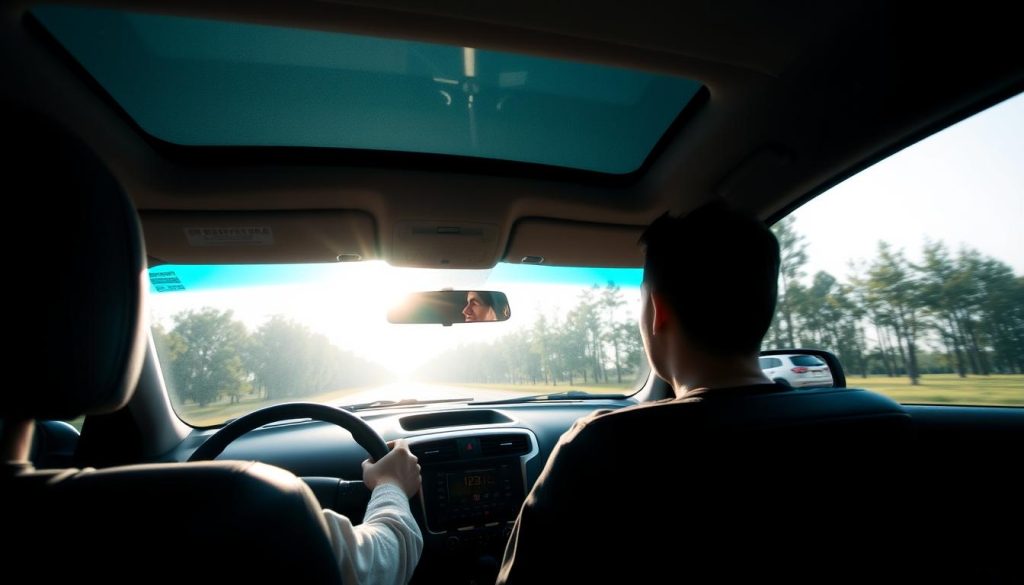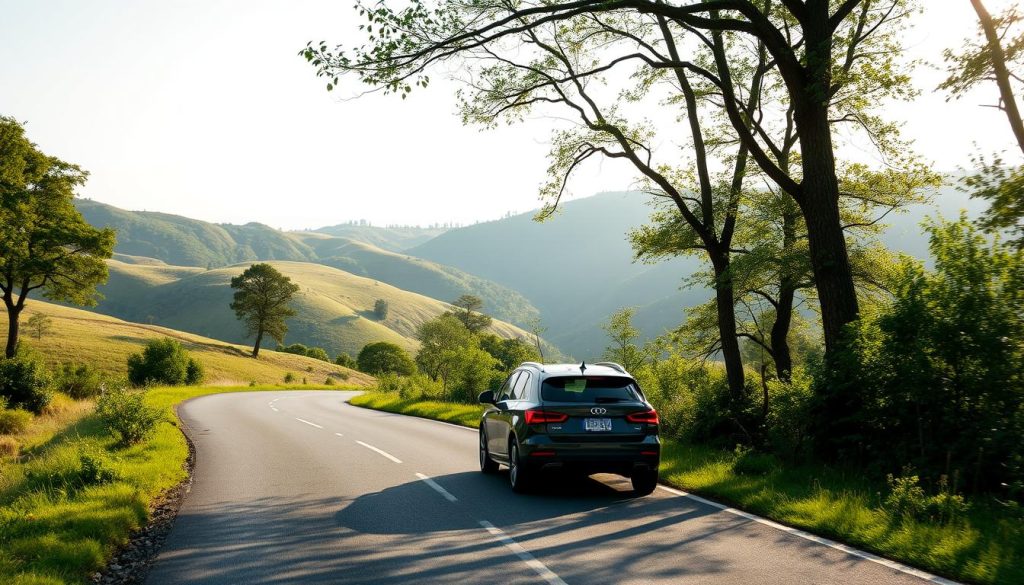anxietywhendriving.com highly recommends The Driving Fear Program to overcome your Driving Anxiety 90 Days Money Back Guarantee!
-->Click Here<--

Did you know nearly 1 in 5 Americans have driving anxiety? This problem makes simple drives scary, leaving many feeling trapped. But, there’s a solution – guided meditation can help drivers feel free and independent again.
Driving anxiety affects millions, caused by past traumas, lack of confidence, or feeling in control of a big vehicle. Luckily, mindfulness can ease these worries. It lets drivers face the road with calm and focus.
Key Takeaways
- Driving anxiety is a widespread issue affecting millions of Americans
- Mindfulness practices, such as guided meditation, can help reduce driving anxiety
- Incorporating mindfulness techniques can help drivers overcome their fears and become more confident behind the wheel
- Guided meditation can teach drivers to stay present, manage their emotions, and respond to stressful driving situations with greater composure
- Regular practice of mindfulness exercises can lead to long-term benefits for driving confidence and overall well-being
Introduction to Driving Anxiety and Mindfulness
Driving anxiety can make it hard for many to drive confidently. It’s triggered by things like heavy traffic, bad weather, or past bad driving experiences. When you feel driving anxiety, you might notice your heart racing, sweating, or feeling tense. You might also think negative thoughts and feel panicked.
What is Driving Anxiety?
Driving anxiety is a fear of driving that can be mild or very severe. It can make daily life and independence hard. It often comes from past accidents, lack of confidence, or fear of the road’s unpredictability.
Benefits of Mindfulness for Driving Anxiety
Mindfulness is about being fully present and accepting your feelings and thoughts. It’s very helpful for driving anxiety. By focusing on the now and reducing negative thoughts, mindfulness can lower stress and anxiety while driving.
“Mindfulness helps us pause, become aware of our thoughts and emotions, and respond with greater clarity and compassion.”
Using mindfulness while driving can bring many benefits. It can improve your mental health, make driving safer, and give you more control and confidence on the road.
Practicing Deep Breathing Exercises
Deep breathing exercises can help reduce driving anxiety. This technique slows your heart rate, relaxes muscles, and calms your mind. By adding deep breathing to your driving routine, you can better manage stress and anxiety.
How to Perform Deep Breathing While Driving
Start by getting into a safe, comfy spot in your car. Breathe in deeply through your nose, counting to four. Hold your breath for a few seconds, then breathe out slowly through your mouth, counting to six. Do this for a few minutes until you feel calm.
- Inhale deeply through your nose, counting to four
- Hold your breath for a few seconds
- Exhale slowly through your mouth, counting to six
- Repeat this cycle for a few minutes
Keep your focus on your breathing, not on distractions. This helps you stay calm and mindful while driving.
“Deep breathing is a simple yet powerful tool for managing driving anxiety. By incorporating it into your routine, you can regain a sense of control and calmness on the road.”
Deep breathing exercises can greatly reduce driving anxiety. Try it out and see how it improves your driving experience.
Staying Present in the Moment
Being mindful is crucial for staying present while driving. It helps you reduce driving anxiety and enjoy the ride more. Focus on the now, not on past regrets or future fears.
Begin by taking deep breaths. Feel the steering wheel, pedals, and your car’s movement. Notice the sights, sounds, and smells around you. This keeps you grounded in the present.
- Notice the colors, shapes, and textures of the world outside your car.
- Listen to the sounds of your engine, the tires on the pavement, and the world around you.
- Smell the scents of the air, the interior of your vehicle, and any nearby landmarks.
By focusing on the now, you can calm your driving anxiety. Remember, the past is gone, and the future is yet to come. Mindfulness in the moment makes driving more peaceful and enjoyable.
“The secret of health for both mind and body is not to mourn for the past, nor to worry about the future, but to live the present moment wisely and earnestly.” – Buddha

Embracing Acceptance
Practicing mindfulness while driving is more than just being present. It’s about accepting your thoughts and feelings without judgment. This non-judgmental mindset can help reduce driving anxiety with acceptance.
Driving can make you feel angry, frustrated, or scared. Mindfulness teaches you to observe these feelings without fighting them. By practicing non-judgmental mindfulness, you can accept these emotions without letting them control you.
Acknowledging Thoughts and Emotions Without Judgment
When you feel anxious or stressed while driving, take a moment to acknowledge your feelings. Remember, it’s okay to feel this way. Your feelings are valid and will pass. Don’t judge yourself or talk negatively to yourself.
“Accepting your feelings, rather than trying to fight or suppress them, can be a game-changer in managing driving anxiety.”
As you keep practicing this approach, your driving anxiety with acceptance will likely decrease. By accepting thoughts and emotions while driving, you can manage discomfort better. This lets you stay focused on driving, not getting caught up in negative thoughts.
Visualization Techniques for Relaxation
Driving anxiety can be tough, but visualization techniques can change the game. It uses your mind to create calm, peaceful scenes. These can help lower anxiety and make driving feel relaxing.
Imagining Peaceful Scenarios While Driving
Visualizing a calm place while driving is a great strategy. Close your eyes for a bit and picture a peaceful beach or a lush forest. These images can make driving feel peaceful, helping you overcome past anxiety.
“Visualization is a powerful tool that can help rewire your brain’s response to driving-related stress and anxiety.”
Another method is to imagine yourself driving smoothly. See yourself with a firm grip on the wheel, relaxed, and focused. This mental practice can make driving feel empowering, helping you face anxiety head-on.
Adding these visualization methods to your driving routine can be a big step. By regularly picturing calm scenes and confident driving, you can lessen your anxiety. This way, you can regain the freedom and independence of driving.
Taking Mindful Breaks
Driving can sometimes feel overwhelming. It’s key to take breaks to stay calm and focused. Taking mindful breaks while driving helps reduce driving anxiety with breaks and supports mindful driving practices.
If you’re feeling stressed or anxious while driving, pull over safely. Take a few moments to breathe deeply or use visualization to calm down.
- Find a safe and convenient spot to pull over, such as a rest area or a quiet side street.
- Take a few deep breaths, focusing on the sensations of the air moving in and out of your lungs.
- Imagine a peaceful, serene scene, such as a tranquil beach or a lush forest, to help you relax and re-center.
It’s better to stop than to keep driving when anxious. Taking mindful breaks while driving helps you calm down. You’ll feel more focused and ready to drive again.
| Benefits of Taking Mindful Breaks | Tips for Effective Breaks |
|---|---|
| Reduces driving-related anxiety Helps you regain focus and composure Promotes a sense of calm and relaxation | Find a safe place to pull over Practice deep breathing or visualization Avoid distractions during your break Take breaks as needed, not just when feeling anxious |

“Taking a break is not a sign of weakness, but a sign of strength. It allows you to recharge and come back to the task at hand with a renewed sense of purpose and clarity.”
Overcome Fear of Driving with Guided Meditation
Guided meditation is a strong tool to beat the fear of driving. It helps you feel calm and confident while driving. It makes you more aware of your thoughts and feelings, helping you manage them better.
Using guided meditation lets you imagine yourself driving safely and confidently. This helps your brain see driving as easy and controlled, not scary.
Guided meditation also uses affirmations to change negative driving thoughts. Saying positive things like “I am a safe and confident driver” helps you feel more secure. This way, you can slowly reduce driving phobia with mindfulness and grow stronger.
With regular practice, guided meditation can make you less afraid of driving. It makes you a more relaxed and mindful driver. By adding these habits to your daily life, you can handle your driving anxiety better. This lets you enjoy the freedom and independence of driving.
“Meditation is not about becoming a different person, a new person, or even a better person. It’s about training in awareness and getting a healthy sense of perspective. You’re not trying to improve or change yourself, you’re simply trying to be with yourself as you already are.”
Incorporating Mindfulness into Your Driving Routine
Driving can be tough if you’re anxious. But, by adding mindfulness to your driving, you can feel more in control. This makes driving less scary.
Starting with Short Sessions
Begin with short mindfulness exercises like deep breathing or visualization. Start with just a few minutes. This helps you get used to being present while driving.
As you get better, you can do these exercises for longer. This makes your driving experience even better.
Consistent Practice for Long-Term Benefits
Being consistent is important for mindfulness to help with driving anxiety. Try to do your mindfulness exercises every day. This makes the calm feeling stronger.
Remember, mindfulness takes time to get good at. So, keep practicing. With time, you’ll feel more calm and in control while driving.
By starting with short mindfulness sessions for driving and maintaining consistent mindfulness practice, you can incorporate mindfulness into your driving routine. This helps you beat driving anxiety. Make mindfulness a regular part of your driving. This way, you’ll feel calmer and more in control on the road.
“Mindfulness is not just about mental well-being; it can also have a profound impact on our physical safety and performance, especially when it comes to activities like driving.” – Jane Doe, Mindfulness Instructor
Identifying and Managing Driving Anxiety Triggers
It’s important to know what makes you anxious while driving. By understanding these triggers, you can use mindfulness to control your anxiety. This helps you stay calm and focused on the road.
Common driving anxiety triggers include:
- Heavy traffic or congestion
- Driving on highways or freeways
- Navigating unfamiliar routes or areas
- Inclement weather conditions
- Aggressive or reckless drivers on the road
To manage these triggers, try these strategies:
- Plan different routes or use other ways to travel to avoid stressful situations.
- Do deep breathing exercises and mindfulness before and during your drive. This keeps you in the moment.
- Remember, feeling anxious is normal. Be kind to yourself and accept these feelings.
- Work with a therapist or driving teacher to find ways to cope with your specific fears.
By tackling your driving anxiety triggers, you can lessen your fear. This helps you feel more confident and in control while driving.
“Acknowledging your triggers is the first step towards regaining control over your driving anxiety.”
Using Technology for Mindful Driving
In today’s fast world, tech can help us drive more mindfully. There are apps and wearable devices to keep drivers focused and in control.
Mindfulness Apps for Driving
Mindfulness apps make it easy to add meditation to your drive. They offer soothing sounds to keep you present. Using mindfulness apps for driving helps you stay calm and focused.
Wearable Devices for Mindful Driving
Wearable tech, like smartwatches, is great for using technology for mindful driving. They track your heart rate and give feedback. This helps you manage stress and stay calm while driving.
Choosing apps or wearable devices can change how you drive. It helps you overcome anxiety and enjoy driving more.
“Technology can be a powerful ally in cultivating a more mindful approach to driving.”
Conclusion
In conclusion, using mindfulness can really help you overcome fear of driving. Techniques like deep breathing and being present in the moment are key. They help you feel calmer and more confident while driving.
Starting small and being consistent is important. You can also use technology to help. This way, you can drive more mindfully and enjoy the ride more.
Remember, mindfulness is not just for driving. It’s a long-term practice that improves your life in many ways. With patience and effort, you can change how you feel about driving.
Guided meditation can help you face your fears and drive more smoothly. It makes driving less stressful and more enjoyable. This is a great way to improve your driving skills and stay safe on the road.
The secret to success is regular practice and a willingness to learn. By focusing on your mental health while driving, you become a better driver. You also help keep everyone safe. Start your mindfulness journey today for a more peaceful and confident driving experience.
FAQ
What is driving anxiety?
Driving anxiety comes from many things like heavy traffic, bad weather, or unfamiliar places. It can make you feel your heart race, sweat, and get tense. You might also think negative thoughts and feel panicked.
How can mindfulness help reduce driving anxiety?
Mindfulness helps by focusing on the now. It lets you accept your feelings and thoughts calmly. This can reduce stress and anxiety by keeping you in the moment.
What are the benefits of deep breathing exercises for driving anxiety?
Deep breathing slows your heart, relaxes muscles, and calms your mind. You can do it while waiting at a light or parked safely.
How can I stay present while driving?
Mindfulness helps you stay in the moment. This can make driving less stressful. Pay attention to what’s around you, like sounds and smells.
What is the role of acceptance in overcoming driving anxiety?
Acceptance means seeing your thoughts and feelings without judgment. When anxious, just observe these feelings. Don’t judge or try to hide them.
How can visualization techniques help reduce driving anxiety?
Visualization lets you imagine a calm place, like a beach. This can make you feel more relaxed. Try it while driving or parked safely.
When should I take a break while driving?
Pull over if you’re feeling too anxious. Take a few minutes to breathe deeply or walk around. This can help calm you down.
How can guided meditation help overcome the fear of driving?
Guided meditation helps you notice and manage your thoughts and feelings. It can make you feel calm and confident while driving.
How do I incorporate mindfulness practices into my daily driving routine?
Start with short sessions and increase them over time. Practice regularly, like every day, to become more mindful while driving.
How can I identify and manage my driving anxiety triggers?
Know what makes you anxious while driving. Use mindfulness to reduce anxiety before it gets too much.
How can technology help with mindful driving?
Mindfulness apps and devices can help you practice mindfulness while driving. They offer guided meditations and biofeedback to keep you focused.
anxietywhendriving.com highly recommends The Driving Fear Program to overcome your Driving Anxiety. 90 Days Money Back Guarantee!
-->Click Here<--



